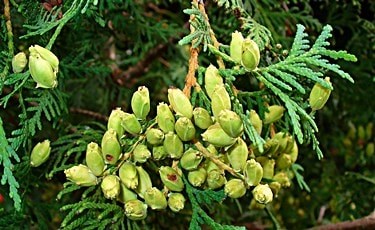Homeopathic remedies have been around since the late 1700’s. They are based on the idea that “like cures like.” This means that a substance that causes the symptoms of a medical condition has the potential to cure that condition. It’s an interesting theory.
While homeopathic treatments are intended to cure the reasons for the condition, the cause of skin tags is not conclusively medically proven. The common belief is that they are caused by skin-on-skin friction.
Skin tags are little more than a small benign growth on the skin. They can appear just about anywhere on the body where there are folds of skin, but they tend to show up on the neck, armpits, and around the eyes. For homeopathic skin tag removal, some are believed to have enjoyed success with thuja occidentalis.
If you’re looking for herbal skin tag removal solutions, homeopathy is a treatment option that doesn’t cause scarring. Let’s take a closer look at the treatment process, possible side effects, and decide if it could work for you.
Using Thuja Occidentalis for Homeopathic Skin Tag Removal
Also known as Eastern arborvitae, Thuja occidentalis is an evergreen tree that’s native to North America. It’s the extract from the arborvitae that has been used to treat multiple health and skin conditions for years.
To use the extract, follow the instructions of the product or apply it once per day. You won’t see instant results after a few applications. However, the potency of the ingredient has helped some people to get rid of skin tags naturally in 4 to 12 weeks.
If your skin tag is larger, the process is likely to take longer. This is because it takes more time to dry out. The success rate is lower for big skin tags, and it may be a good idea to get a biopsy performed to make sure that it’s non-malignant.
What Are the Side Effects of Thuja Occidentalis?
Because thuja occidentalis extract is completely natural, there are no chemically-induced side effects caused by the external application. However, when used in large doses or consumed orally, the extract can be toxic. It has been known to cause the following side effects:
- Convulsions
- Vomiting
- Headaches
- Hypotension
If you’re not directly ingesting the product and adhere to the recommended dosage, these issues are unlikely.
Keep in mind that the extract does have a strong and distinctive ‘woody’ scent. This isn’t a problem for most people, but it’s something to know about if you’re spending time in the company of others at work or socially.
Best Over-the-Counter Homeopathic Skin Tag Products
Thuja occidentalis is the key ingredient in most homeopathic skin tag solutions, like Nature’s Pillow Tag Away. It contains other natural oils, like melaleuca alternifolia and ricinus communis seed oil. Here’s some additional information on the ingredients:
- Melaleuca alternifolia is another name for tea tree oil. This is a commonly-used treatment option for skin tags. Australian tea tree oil has antiseptic, antiviral, antifungal, and anti-inflammatory properties.
- Ricinus communis seed oil is also known as castor oil. It is another way that some people use to treat skin tags. It’s made into a paste with baking soda.
- Cedar leaf oil is also a key ingredient in Tag Away, and other over the counter homeopathic skin tag products. However, it’s just an alternative name for the actual Thuja oil. You may also see it listed as cedarwood oil.
Some products contain a mixture of these ingredients:
Many of these products suggest using them up to three times daily. So, be sure to follow the instructions on each product to get the best results. If you experience any negative side effects, stop treatment immediately.
Additional Homeopathic Ingredients
Thuja occidentalis is the most commonly used and most effective of the homeopathic skin tag treatments, but there are alternatives. Here are some of the other options to consider:
- Oregano oil can work for skin tag removal as it dries out the skin tag.
- Apple cider vinegar has acidic properties that are believed to ‘decay’ the growth.
- A tincture that consists of water and black walnut hull has anecdotal success.
The formula can be applied with cotton wool or a Q-tip. You can put a bandage over the cotton and leave it in place overnight to help with absorption.
After many weeks, you may notice that your skin tag start to shrivel or discolor. Different methods work for different people, so you will have to experiment if you want to find a natural treatment.

A Natural Solution for Treating Skin Tags
Because skin tags are benign and not painful, it’s not uncommon to want to seek out a natural treatment. Medical solutions, like cauterization and freezing skin tags, can be invasive and aren’t covered by insurance.
A skin tag needs to be cut off from oxygen and blood flow to fall off on its own. This can be done in a variety of different ways. However, you should never attempt to pick at or pull off a skin tag.
By using a potent mixture of natural ingredients, a homeopathic skin tag removal treatment is a safe way to get rid of skin tags at home. Without the worry of serious negative side effects, you can use a homeopathic product as directed. But, they may not be as effective as other OTC products, such as Apothecary tea tree oil.
